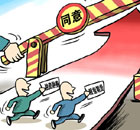Op-Ed Contributors
Equal plan of emissions rights
By Chen Longxiang (China Daily)
Updated: 2010-02-01 07:47
 |
Large Medium Small |
The most crucial task for China in international climate talks is to seek an equal arrangement of emission rights that could guarantee its development interests and basic human rights, says Ding Zhongli, a renowned geologist and vice-president of the Chinese Academy of Sciences in an interview with China Daily.
While in allocating emissions rights - or the quota of emissions - for different countries, the reduction proposals of the IPCC (United Nations' Intergovernmental Panel on Climate Change), the G8 and the OECD (Organization of Economic Cooperation and Development) did not consider that the cumulative emissions per capita of developed countries throughout modern history (from 1900 to 2005) has been 7.54 times that of developing countries.
| ||||
Due to the gigantic differences in the historically cumulative emissions amounts and the current emissions base quota, if considering how much different countries have reduced in emissions in a bid to control atmospheric CO2 concentration, it would screen the differences in emissions in history and per capita, resulting in an unjustified outcome, Ding says.
In his paper on the major proposals for carbon emissions reduction and some related issues, published on February issue of "Science in China", Ding analyzed the trap hidden in the dialogue on emissions reduction.
The "trap" consists of: First, demonstrating the high sensitivity of global temperatures to atmospheric CO2 concentration; second, emphasizing the catastrophic impacts of global warming on the biosphere and on humans; third, making the value judgment that the extent of temperature increases since the Industrial Revolution should be controlled under 2 C within this century; fourth, calculating that the atmospheric CO2 equivalent concentration should not exceed 450 parts per million by volume within the 2 C model; fifth, defining the responsibilities of developing countries in terms of long-term emissions reductions; sixth, fixing the quota of developing countries in long-term emissions reduction.
The key point here is that once the concentration target of 450 ppmv is established, the permitted emissions from fossil fuel combustion and cement production from 2006 to 2050 are fixed accordingly.
Even though the ocean and land continue to absorb 45 percent of carbon emissions, the total amount of emissions that people all over the world could discharge is at about 255.11 GtC. In the total amount of emissions, however, after developed countries determine their proportion of how much they should reduce, there is not much vacancy left for developing countries to exercise emissions freedom.
Developing countries may not be fully aware of the "trap". For example, some negotiators from developing countries have long been stressing that developed countries should cut it by 40 percent by 2020 from the 1990 levels. In fact, regardless of whether developed countries can make that target or even though they reach that target, the emissions quota left to developing countries is very limited, Ding said.
Therefore, these proposals (including those of the IPCC, the G8 and the OECD) have violated the international principles of justice and fairness and also go against the principle of "common but different responsibilities" endorsed by the United Nations Framework Convention on Climate Change and the Kyoto Protocol. These proposals have no legitimacy to be taken as the basis of further international climate change negotiations.
As the world's most populous country, it is normal that China's emissions amount and methods are of great concern worldwide. But it goes without saying that China strives for emissions equality, given its huge development gaps among regions, its large impoverished population, high-speed industrialization and current urbanization rate of about 45 percent.
According to the three proposals, however, China should receive an emissions quota of less than 20 years, which means that no later than 2026 China has to buy emission rights from other countries. Certainly, China can't accept this. This is the crux that concerns the impartiality of emissions rights distribution.
The world undoubtedly is mankind's common system and the atmosphere is a public resource shared by everybody. It is men's natural right in the use or distribution of any substance, including the composition emitted by anthropic activity that also should reflect the principle of impartiality. So, in discussion of future emissions rights, the historically cumulative emissions per capita of each country that has already emitted CO2 should be considered, and then the future emissions quota of each country should be calculated.
As a world power with responsibility, China could resort to the subject of "cumulative emissions per capita" in negotiations. If the international community could truly adhere to the principles of fairness and justice and control carbon emissions through cumulative quotas, China could not only strive for more emissions rights but also break the chains imposed on China by some countries, establishing an image of confident and responsible power in international affairs.
(China Daily 02/01/2010 page8)












